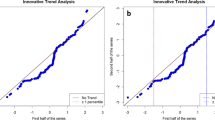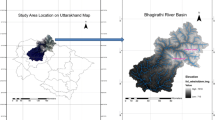Abstract
Drought is considered to be an extreme climatic event causing significant damage both in the natural environment and in human lives. Due to the important role of drought forecasting in water resources planning and management and the stochastic behavior of drought, a multiplicative seasonal autoregressive integrated moving average (SARIMA) model is applied to the monthly streamflow forecasting of the Zayandehrud River in western Isfahan province, Iran. After forecasting 12 leading month streamflow, four drought thresholds including streamflow mean, monthly streamflow mean, 2-, 5-, 10- and 20-year return period monthly drought and standardized streamflow index were chosen. Both observed and forecasted streamflow showed a drought period with different severity in the lead-time. This study also demonstrates the usefulness of SARIMA models in forecasting, water resources planning and management.














Similar content being viewed by others
References
American Meteorological Society (AMS) (2004) Statement on meteorological drought. Bull Am Meteorol Soc 85:771–773
Bonacci O (1993) Hydrological identification of drought. Hydrol Process 7:249–262
Box GEP, Jenkins GM (1976) Time series analysis, forecasting and control, revised edn. Holden-Day, San Francisco
Bowerman BL, O’Connel RT (1993) Forecasting and time series, an applied approach. Duxbury, Pasific Grove
Brath A, Rosso R (1993) Adaptive calibration of a conceptual model for flash flood forecasting. Water Resour Res 29(8):2561–2572
Breusch T, Pagan A (1979) A simple test of heteroscedasticity and random coefficient variation. Econometrica 47:1287–1294
Chang TJ, Kleopa XA (1991) A proposed method for drought monitoring. Water Resour Bull 27:275–281
Chang TJ, Stenson JR (1990) Is it realistic to define a 100-year drought for water management? Water Resour Bull 26:823–829
Chung CH, Salas JD (2000) Drought occurrence probabilities and risks of dependent hydrological processes. J Hydrol Eng ASCE 5(3):259–268
Clausen B, Pearson CP (1995) Regional frequency analysis of annual maximum streamflow drought. J Hydrol 173:111–130
Conover WJ (1980) Practical nonparametic statistics, 2nd edn. Wiley, New York
Delleur JW, Tao PC, Kavas ML (1976) An evaluation of practicality and complexity of some rainfall and runoff time series models. Water Resour Res 12(5):953–970
Dracup JA, Lee KS, Paulson EG Jr (1980) On the definition of droughts. Water Resour Res 16:297–302
Efron B, Tibshirani RJ (1993) An introduction to the bootstrap. Chapman and Hall, New York
Griffiths GA (1990) Rainfall deficit: distribution of monthly runs. J Hydrol 115:219–229
Hanson RT, Newhouse MW, Dettinger MD (2004) A methodology to assess relations between climatic variability and variations in hydrologic time series in the southwestern United States. J Hydrol 287:252–269
Hipel KW (1993) Practical results in simulation and forecasting. In: Macro JB, Harboe R, Salas JD (eds) Stochastic hydrology and its use in water resources systems simulation and optimization. NATO Advanced Study Institute, Kluwer Academic Publishers, Dordrecht, Netherlands pp. 175–188
Hipel KW, McLeod AE (1994) Time series modeling of water resources and environmental systems. Elsevier, Amsterdam, The Netherlands
Hollander M, Wolfe DA (1999) Nonparametric statistical methods. Wiley, New York
Khan MS, Coulibaly P, Dibike Y (2006) Uncertainty analysis of statistical downscaling methods. J Hydrol 319:357–382
Kim T, Valdes JB (2003) Nonlinear model for drought forecasting based on a conjunction of wavelet transforms and neural networks. J Hydrol Eng ASCE 8(6):319–328
Levene H (1960) Contributions to probability and statistics. Stanford University Press, Stanford
Loaiciga HA, Leipnik RB (1996) Stochastic renewal model of low-flow stream sequences. Stochastic Hydrol Hydraulics 10(1):65–85
Lohani VK, Loganathan GV (1997) An early warning system for drought management using the Palmer drought index. J Am Water Resour Assoc 33(6):1375–1386
Loukas A, Vasiliades L (2004) Probabilistic analysis of drought spatiotemporal characteristics in Thessaly region, Greece. Nat Hazard Earth Syst Sci 4:719–731
McKee TB, Doesken NJ, Kleist J (1993) The relationship of drought frequency and duration to time scales. In: Proceedings of the 8th conference on applied climatology, Anaheim, American Meteorological Society, pp. 179–184
Mishra AK, Desai VR (2005) Drought forecasting using stochastic models. Stochastic Environ Res Risk Assess 19:326–329
Salas JD, Obeysekera JTB (1982) ARMA model identification of hydrologic time series. Water Resour Res 18(4):1011–1021
Salas JD, Delleur JW, Yevjevich VM, Lane WL (1980) Applied modeling of hydrologic time series. Water Resources Publications, Littleton
Sen Z (1976) Wet and dry periods of annual flow series. J Hydraulics Div ASCE 106(HY1):99–115
Sen Z (1977) Run sums of annual flow series. J Hydrol 35:311–324
Yevjevich V (1967) An objective approach to definitions and investigations of continental hydrologic droughts. Hydrology Papers Colorado State University, Fort Collins
Yurekli K, Kurunc K, Ozturk F (2005) Application of linear stochastic models to monthly flow data of Kelkit Stream. Ecol Model 183:67–75
Wilhite DA, Glantz MH (1985) Understanding the drought phenomenon: the role of definitions. Water Int 10:111–120
Wilhite DA, Rosenberg NJ, Glantz MH (1986) Improving federal response to drought. J Clim Appl Meteorol 25:332–342
Zelenhasic E, Salvai A (1987) A method of streamflow drought analysis. Water Resour Res 23:156–168
Acknowledgements
The author is grateful to two anonymous reviewers for their comments, which helped improve presentation significantly. The comments from Z. Sen, C. Chatfield and A. Mishra are also appreciated. The author also thanks George Christakos, the Editor-in-Chief of the journal of Stochastic Environmental Research and Risk Assessment.
Author information
Authors and Affiliations
Corresponding author
Rights and permissions
About this article
Cite this article
Modarres, R. Streamflow drought time series forecasting. Stoch Environ Res Ris Assess 21, 223–233 (2007). https://doi.org/10.1007/s00477-006-0058-1
Published:
Issue Date:
DOI: https://doi.org/10.1007/s00477-006-0058-1




